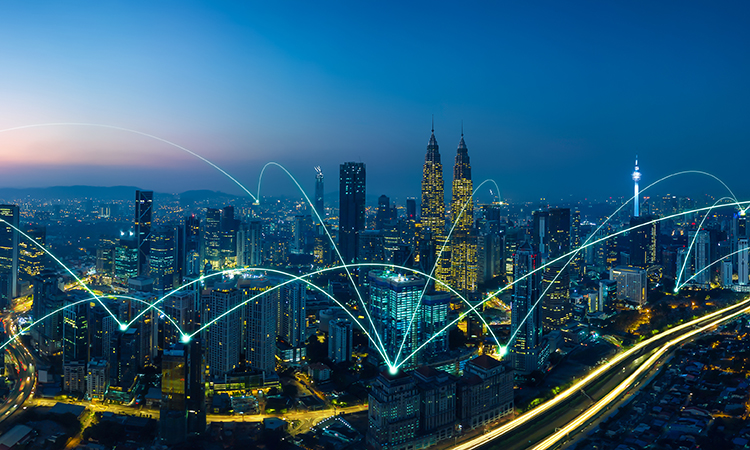Serving passengers better with enhanced IoT and connectivity
- Like
- Digg
- Del
- Tumblr
- VKontakte
- Buffer
- Love This
- Odnoklassniki
- Meneame
- Blogger
- Amazon
- Yahoo Mail
- Gmail
- AOL
- Newsvine
- HackerNews
- Evernote
- MySpace
- Mail.ru
- Viadeo
- Line
- Comments
- Yummly
- SMS
- Viber
- Telegram
- Subscribe
- Skype
- Facebook Messenger
- Kakao
- LiveJournal
- Yammer
- Edgar
- Fintel
- Mix
- Instapaper
- Copy Link
Posted: 7 November 2022 | Paul Vaclik - Nomad Digital | No comments yet
Paul Vaclik, Head of R&D and Architecture at Nomad Digital, considers the impact that improved connectivity and IoT has on passengers and operators alike, and shares his thoughts on what the future of connectivity may look like.


How has the development of Internet of Things (IoT) accelerated and adapted since its origins in 1999?
The internet was originally developed to connect ‘things’ rather than people, being large computers in the basements of universities and governments that were invisible to most of us. We are all living through an explosion of internet-delivered services which focus on people, not things; with approximately five billion of us (at the last count) connecting to friends, work, education, entertainment – everything.
Even though our world is becoming ever more complex, systems which serve our daily lives and protect us are now more reliable and can react more predictively to solve problems”
In the background, there has been an even bigger explosion of things being equipped with enough technology to sense measure their environment or their current state and connect to the internet. There are now more than 14 billion of these smart connected devices sending data about their state and their environment. The range of information that can be gathered from all of these things is truly immense – from sensors which measure the quality of the environment around them, to strain gauges embedded in buildings that can give pre-warning of structural faults, to batteries that can tell you when they need replacing, to toilets that can report that they need cleaning.
All of this data is used to build a detailed picture of how remote systems are working and if, or when, they might need some attention. The data also builds models of the environments that surround us, enabling smart systems to help to guide passenger flow to minimise congestion.
As a result, even though our world is becoming ever more complex, systems which serve our daily lives and protect us are now more reliable and can react more predictively to solve problems before they affect us.
How does improved connectivity benefit both transport operators and their passengers?
Reliable, secure, high-capacity connectivity between a vehicle and remotely located services allows transport operators to offer a range of services to passengers which would otherwise be impossible. These include on-board internet; up-to-date travel information and news; regularly updated on-board entertainment; and services requiring real-time card payments (such as buffet service).
Connectivity also allows operators to gather detailed, near real-time data and take advantage of cost-effective, cloud-based tools to use that data. This enables more centralised monitoring and management of services.


The passenger experience has changed exponentially over the past few years, mainly due to an increased adoption of technological innovations. In what ways has IoT played a role in this?
A modern train or bus is full of sensors and devices which monitor the state of the vehicle itself and many of the facilities within. Over time, more of these devices are network enabled, allowing data to be easily aggregated and communicated both with the vehicle and to remote systems. Many of these sensors provide information about the mechanical and electrical systems on the vehicle, e.g. brake wear, engine temperature, fluid levels and battery use. An increasing number of sensors also monitor the passenger environment. These could include load sensors, passenger counting devices, environmental sensors, seat occupancy sensors etc.
IoT technology provides a set of tools to allow devices and sensors to be connected, via a range of communications technologies, and to share their data by well known, easy to implement standards”
IoT technology provides a set of tools to allow devices and sensors to be connected, via a range of communications technologies, and to share their data by well known, easy to implement standards. This helps to bring data from many sources together in a consistent way so that models can be built that include data from a wide range of sources. Using data from many sources provides the information that machine learning (ML) and artificial intelligence (AI) algorithms (as well as more conventional statistical analysis) require to create alerts and predictions to dynamically make changes which improve the passenger experience.
One of the most significant innovations that the public transport industry has adopted is smart ticketing, which impacts passengers in a variety of ways. What technologies contribute to these newer forms of ticketing, and how do they ultimately improve a passenger’s journey?
Smart ticketing requires reliable, secure communication to handle payments and to validate passengers quickly, with as little impact on the passenger as possible”
Smart ticketing requires reliable, secure communication to handle payments and to validate passengers quickly, with as little impact on the passenger as possible. The aim is to create a seamless experience for the passenger, so it needs to work efficiently at all times to avoid creating delays and congestion. A traditional paper ticket identified the bearer as being free to travel. If you take away the physical ticket, then other forms of identification are needed, whether that be the passenger’s payment card, smartphone, smartwatch or biometric data. All of these solutions need three things: sensors to capture identification data; a central ‘identity provider’ to keep a database of valid journeys; and connectivity between those components.
Contactless payment cards make it possible to use a ‘tap in, tap out’ system to track each journey segment that a passenger takes with a single payment. Smart devices offer a number of ways to connect to sensors; for example, Wi-Fi, Bluetooth or Near Field Communication (NFT), all of which can be combined with secure digital certificates held on the device to identify the device. To combat fraud, we are increasingly using multi-factor authentication for payments and to connect to systems. It is likely that ticketless travel solutions will follow this pattern, so we will see combinations of the above technologies used.
Speed and reliability are two key factors that are important to passengers when travelling on public transport, and the industry has committed to enhance both. Can IoT and improved connectivity help to deliver on this commitment and, if so, how?
Smart IoT devices provide train operators with a detailed, near real-time view of their infrastructure and the passenger environment. That data, combined with powerful monitoring and modelling software, replaces the need for constant physical inspection and can help to predict when equipment requires servicing or replacement before a fault occurs. Thereby allowing operators to use predictive, planned maintenance in a way that does not impact passenger service, rather than having to deal with failures whilst fleets are in service.
What do you think the future of connectivity looks like?
Cellular technology – 5G and beyond – will continue to evolve such that we have high capacity, ‘always on’ connectivity for a greater part of our daily life, but the fastest evolution of these services will always focus on areas of dense population. It is neither technically nor economically feasible to deliver the same level of connectivity everywhere. We will see an increasing number of technologies being used to ‘fill in the gaps’, so as to deliver more consistent connectivity wherever we go.
We will see an increasing number of technologies being used to ‘fill in the gaps’, so as to deliver more consistent connectivity wherever we go”
Right now, our cellular devices do a pretty good job of delivering the best service that they can at any location without the user needing to do anything. Our devices switch between 2/3G, 4G and 5G seamlessly and even connect automatically to other networks when we cross borders or land at an airport. The experience with Wi-Fi is not currently so seamless. Choosing and connecting to a Wi-Fi service for the first time still normally needs some kind of user interaction. We will increasingly see solutions such as Open Roaming addressing this, delivering a more seamless experience which uses the best of cellular and Wi-Fi connectivity wherever it is available.
Delivering high-capacity Wi-Fi connectivity can be challenging in remote locations and in moving vehicles. We can expect wider deployment of long range 5G and emerging technologies, such as low-earth-orbit satellite-delivered internet to help with this, but there will be an increasing focus on delivering dedicated radio networks – particularly on clearly defined routes such as major rail routes.


Paul is an IT professional with over 30 years’ experience in project, programme and department management. His background in electronic engineering and extensive career in software design and development of data-driven systems puts him in an ideal position to deliver Nomad’s combination of hardware and software product offerings. He is trained in PRINCE2 and DSDM methodologies, so can work equally well in both waterfall and agile software development environments.
Related topics
5G & Transport Communications, Artificial Intelligence, Connected & Autonomous Vehicles, Fleet Management & Maintenance, IoT (Internet of Things), Passenger Experience, Public Transport, Ticketing & Payments, Travel & Passenger Information
Related modes
Rail
Related organisations
Nomad Digital
Related people
Paul Vaclik







